Knowing Alexander Mendel and his studies of peas law
Hi steemians! Mendel's studies are an example of the correct use of the scientific method. His works have allowed to describe the fundamental tools of the inheritance, now known as Mendel's law, thanks to which it was possible to know the mechanisms of inheritance in the organisms of sexual reproduction.

each individual who reproduces sexually transfers his or her descendants to exactly half of their genetic information. Until that time, it was believed that the inherited phenotypes were an average of the characteristics of the parents.
It is thanks to the incredible dimension of his discoveries that, early twentieth century, he is recognized as the father of the new science of genetics.
History of Gregor Mendel
Gregor Mendel, considered the father of genetics, was an Austrian monk whose experiments on the transmission of hereditary characters have become the basis of the current theory of heredity. Mendel's laws explain the traits of the descendants, from the knowledge of the characteristics of their parents
Gregor Mendel was born on July 22, 1822 in Heizendorf (now Hyncice, Czech Republic), into a family of peasants. Family and economic difficulties forced him to delay his studies. He was a man of morbid constitution and humble and withdrawn character. The sociocultural environment influenced his scientific personality, mainly the direct contact with nature, the teachings of his father about fruit crops and the relationship with. different teachers throughout his life, especially Professor J. Scheider, an expert in pomology.
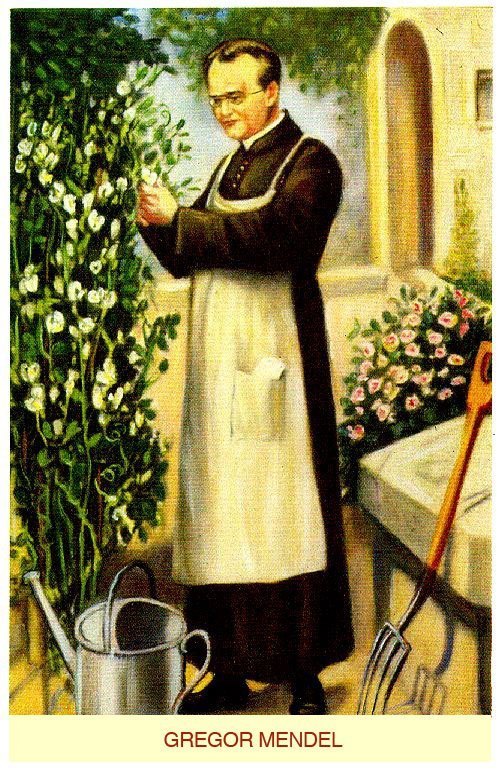
His knowledge in science and gardening led Mendel to study garden pea (Pisum sativum) for two main reasons. In the first place, it had a wide variety of peas in the market of different shapes and colors that could be easily identified and analyzed. Second, peas can self-pollinate (a single pea can give rise to others identical to it) or cross by cross-pollination. The gardener, or the researcher, can cross two pea plants at will (cross-pollination) or let them self-pollinate. Other practical reasons for choosing Mendel were that the peas were cheap and easy to obtain, that they occupied little space, that they had a short generation time and that they produced many descendants.
When typifying the phenotypic characteristics (external appearance) of the peas, he called them characters. He used the element name to refer to separate hereditary entities. The elements subsequently received an infinity of names, but today they are universally known as genes, a term used in 1909 by the Danish biologist Wilhem Ludwig Johannsen.
Study of plants and experiment
Mendel began his experiments by choosing two plants of peas that differed in some character: the kind of seeds (yellow or green, smooth or wrinkled), and the color of the flowers (white or colored). The first phase of the experiment consisted of obtaining, through conventional crops, constant pure lines and collecting methodically part of the seeds produced by each plant. Then crossed these strains through the technique of cross pollination. In this way it was possible to combine different varieties that presented precise phenotypic differences among themselves.
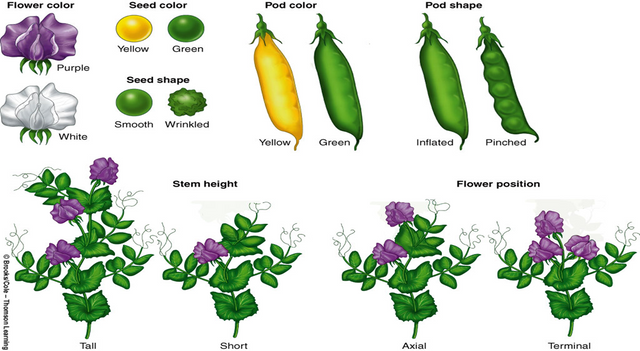
Mendel's first law
Before beginning to delve into Mendel's first Law, certain basic concepts must be known in order to better understand each of the procedures, trials and conclusions of Mendelian genetics.
The first concept is the Mendelian factor, which is known more as a Gen, and is an area within DNA to encode RNA. There are also the genotype which are the hereditary factors of the organisms, and the phenotype which are the physical features or visible characteristics of an individual of a certain species. The latter describes the physiology, morphology and even the behavior of an organism.
The first law of Mendel, also called: Law of uniformity of hybrids of the first generation, or simply Law of Uniformity. This law dictates that, when crossing two varieties of a pure race species, each of the hybrids of the first generation will have certain characteristics similar in phenotype. This is because pure races have a dominant gene or a recessive gene. The dominant genotype will then be the one that determines the main characteristics or characteristics of the first generation of the crossing, but at the same time, they will also be phenotypically similar to each other, that is, between each individual of the first generation.
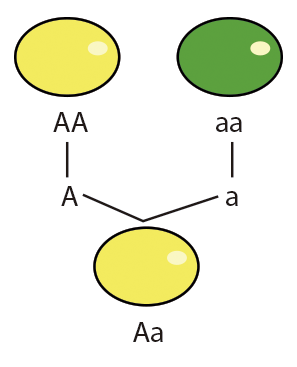
In the experiment conducted by Mendel to obtain the first of Mendel's laws, he used a kind of peas that produced yellow seeds as the dominant gene and another that had a recessive gene that produced green seeds, therefore, the allele that we will call "A "Gave the yellow color above the" a "allele that produced the green color. The product of the crossing were plants that produced yellow seeds.
Second Law of Mendel
In this Second Law of Mendel is fulfilled in the second generation filial, that is to say that from the parents to the first generation, the First Law of Mendel is fulfilled, and then of the children of the first generation this Second Law of Mendel is fulfilled.
The second law of Mendel, also known as the Law of Segregation, Law of Equitable Separation, or even Law of Dissolution of Alleles. This dictates that for there to be reproduction of two individuals of a species, first there must be separation of the allele from each of the pairs so that in this way the genetic information is transferred to the child. An allele is the genetic variant that allows you to determine a trait or character. There are, then, dominant alleles and recessive alleles.
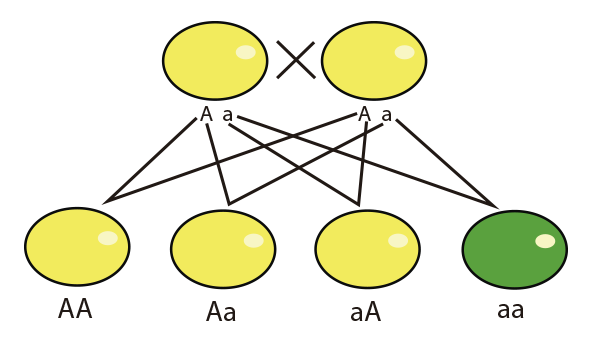
In this Second Law of Mendel is fulfilled in the second generation filial, that is to say that from the parents to the first generation, the First Law of Mendel is fulfilled, and then of the children of the first generation this Second Law of Mendel is fulfilled.
The second law of Mendel, also known as the Law of Segregation, Law of Equitable Separation, or even Law of Dissolution of Alleles. This dictates that for there to be reproduction of two individuals of a species, first there must be separation of the allele from each of the pairs so that in this way the genetic information is transferred to the child. An allele is the genetic variant that allows you to determine a trait or character. There are, then, dominant alleles and recessive alleles.
Mendel's Third Law
Mendel's third law, also called the Independent Character Heritage Act or the Independent Association Law. According to Mendel, there are inherited traits that are obtained independently, unrelated to the phenotype, which does not affect the inheritance pattern of other traits. This law is fulfilled in genes that are not linked, that is, they are found in different chromosomes or that are in very separate zones of the same chromosome.
Mendel, to conclude the third of Mendel's laws, made a cross between pea plants that produced yellow and flat seeds, with peas that produced green seeds with irregular texture. These were homozygous for the two texture and color characters. It was concluded that the law of uniformity was present, because with the first generation it was possible to obtain yellow and smooth seeds.
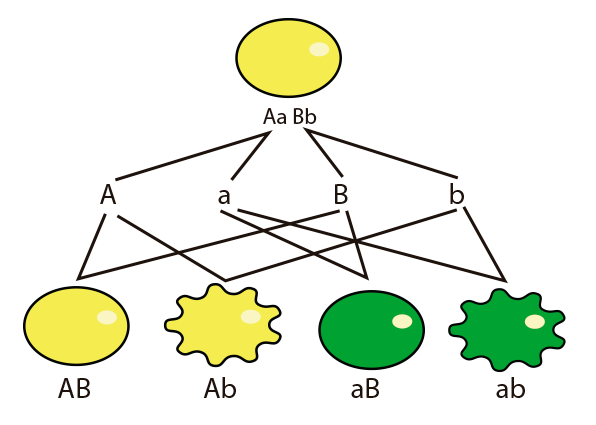
However, new types of seeds with similar and similar ones were observed with the parental generation, yellow and smooth seeds were obtained, yellow and rough, green and smooth, and green and rough.
To conclude with Mendel's Laws, it can be said that Mendel's First Law says that if two purebred parents with different traits intersect, the first generation will have similarities to each other and maintain a character of the father with the dominant allele. The second law says that genetic factors are separated from each of the parents in individual alleles that will join to procreate offspring with the characteristics of the first generation, but in the second generation, new genetic characteristics observed in the parents but united in a way random in the offspring of the first generation. And Mendel's third law says that, in addition, there are features generated independently, through distant chromosomes that do not intervene with each other, and as in the second law, this third part of Mendel's laws is more clearly manifested in the second generation of individuals.
Thank you for your attention.
- For more information, visit the following link
- https://leyesdemendel.com/
- https://www.educ.ar/recursos/111416/gregor-mendel-la-historia-en-los-genes
- https://tecnologiajesusarias.wordpress.com/2011/10/18/el-padre-de-la-genetica-gregor-mendel/
Greetings!
Good lesson! Maybe your next one can be on DNA.
Muy instructivo, me acordaste a mis clases de biologia del liceo
esas clases que nos hacian sufrir cuando no entendiamos nada, cierto @maikelsoto